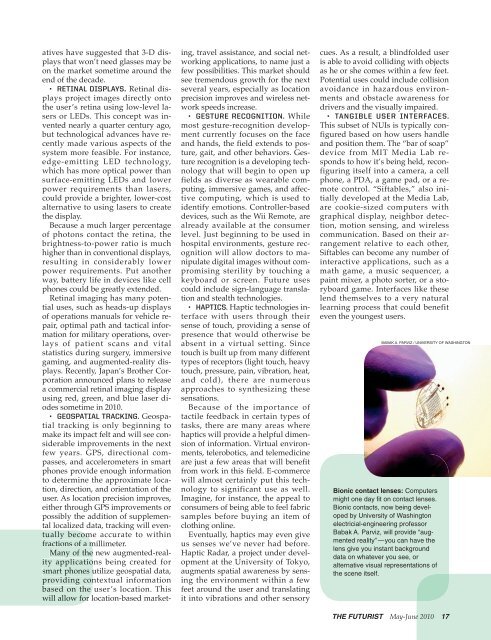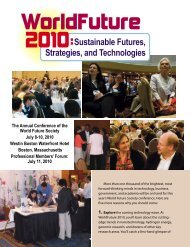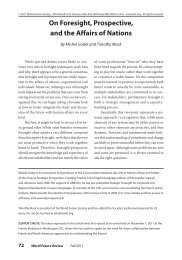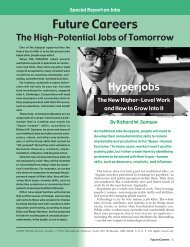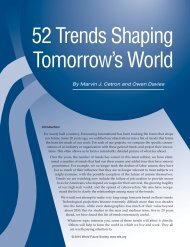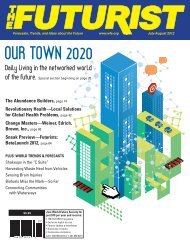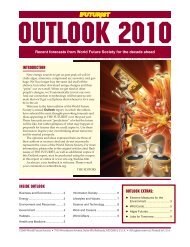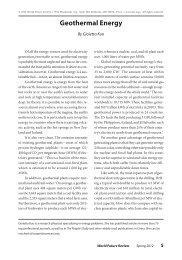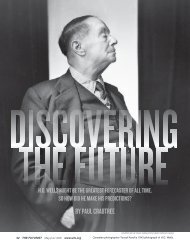THE AGE - World Future Society
THE AGE - World Future Society
THE AGE - World Future Society
You also want an ePaper? Increase the reach of your titles
YUMPU automatically turns print PDFs into web optimized ePapers that Google loves.
atives have suggested that 3-D displays<br />
that won’t need glasses may be<br />
on the market sometime around the<br />
end of the decade.<br />
• RETINAL DISPLAYS. Retinal displays<br />
project images directly onto<br />
the user’s retina using low-level lasers<br />
or LEDs. This concept was invented<br />
nearly a quarter century ago,<br />
but technological advances have recently<br />
made various aspects of the<br />
system more feasible. For instance,<br />
edge-emitting LED technology,<br />
which has more optical power than<br />
surface-emitting LEDs and lower<br />
power requirements than lasers,<br />
could provide a brighter, lower-cost<br />
alternative to using lasers to create<br />
the display.<br />
Because a much larger percentage<br />
of photons contact the retina, the<br />
brightness-to-power ratio is much<br />
higher than in conventional displays,<br />
resulting in considerably lower<br />
power requirements. Put another<br />
way, battery life in devices like cell<br />
phones could be greatly extended.<br />
Retinal imaging has many potential<br />
uses, such as heads-up displays<br />
of operations manuals for vehicle repair,<br />
optimal path and tactical information<br />
for military operations, overlays<br />
of patient scans and vital<br />
statistics during surgery, immersive<br />
gaming, and augmented-reality displays.<br />
Recently, Japan’s Brother Corporation<br />
announced plans to release<br />
a commercial retinal imaging display<br />
using red, green, and blue laser diodes<br />
sometime in 2010.<br />
• GEOSPATIAL TRACKING. Geospatial<br />
tracking is only beginning to<br />
make its impact felt and will see considerable<br />
improvements in the next<br />
few years. GPS, directional compasses,<br />
and accelerometers in smart<br />
phones provide enough information<br />
to determine the approximate location,<br />
direction, and orientation of the<br />
user. As location precision improves,<br />
either through GPS improvements or<br />
possibly the addition of supplemental<br />
localized data, tracking will eventually<br />
become accurate to within<br />
fractions of a millimeter.<br />
Many of the new augmented-reality<br />
applications being created for<br />
smart phones utilize geospatial data,<br />
providing contextual information<br />
based on the user’s location. This<br />
will allow for location-based market-<br />
ing, travel assistance, and social networking<br />
applications, to name just a<br />
few possibilities. This market should<br />
see tremendous growth for the next<br />
several years, especially as location<br />
precision improves and wireless network<br />
speeds increase.<br />
• GESTURE RECOGNITION. While<br />
most gesture-recognition development<br />
currently focuses on the face<br />
and hands, the field extends to posture,<br />
gait, and other behaviors. Gesture<br />
recognition is a developing technology<br />
that will begin to open up<br />
fields as diverse as wearable computing,<br />
immersive games, and affective<br />
computing, which is used to<br />
identify emotions. Controller-based<br />
devices, such as the Wii Remote, are<br />
already available at the consumer<br />
level. Just beginning to be used in<br />
hospital environments, gesture recognition<br />
will allow doctors to manipulate<br />
digital images without compromising<br />
sterility by touching a<br />
keyboard or screen. <strong>Future</strong> uses<br />
could include sign- language translation<br />
and stealth technologies.<br />
• HAPTICS. Haptic technologies interface<br />
with users through their<br />
sense of touch, providing a sense of<br />
presence that would otherwise be<br />
absent in a virtual setting. Since<br />
touch is built up from many different<br />
types of receptors (light touch, heavy<br />
touch, pressure, pain, vibration, heat,<br />
and cold), there are numerous<br />
approaches to synthesizing these<br />
sensations.<br />
Because of the importance of<br />
tactile feedback in certain types of<br />
tasks, there are many areas where<br />
haptics will provide a helpful dimension<br />
of information. Virtual environments,<br />
telerobotics, and telemedicine<br />
are just a few areas that will benefit<br />
from work in this field. E-commerce<br />
will almost certainly put this technology<br />
to significant use as well.<br />
Imagine, for instance, the appeal to<br />
consumers of being able to feel fabric<br />
samples before buying an item of<br />
clothing online.<br />
Eventually, haptics may even give<br />
us senses we’ve never had before.<br />
Haptic Radar, a project under development<br />
at the University of Tokyo,<br />
augments spatial awareness by sensing<br />
the environment within a few<br />
feet around the user and translating<br />
it into vibrations and other sensory<br />
cues. As a result, a blindfolded user<br />
is able to avoid colliding with objects<br />
as he or she comes within a few feet.<br />
Potential uses could include collision<br />
avoidance in hazardous environments<br />
and obstacle awareness for<br />
drivers and the visually impaired.<br />
• TANGIBLE USER INTERFACES.<br />
This subset of NUIs is typically configured<br />
based on how users handle<br />
and position them. The “bar of soap”<br />
device from MIT Media Lab responds<br />
to how it’s being held, reconfiguring<br />
itself into a camera, a cell<br />
phone, a PDA, a game pad, or a remote<br />
control. “Siftables,” also initially<br />
developed at the Media Lab,<br />
are cookie-sized computers with<br />
graphical display, neighbor detection,<br />
motion sensing, and wireless<br />
communication. Based on their arrangement<br />
relative to each other,<br />
Siftables can become any number of<br />
interactive applications, such as a<br />
math game, a music sequencer, a<br />
paint mixer, a photo sorter, or a storyboard<br />
game. Interfaces like these<br />
lend themselves to a very natural<br />
learning process that could benefit<br />
even the youngest users.<br />
BABAK A. PARVIZ / UNIVERSITY OF WASHINGTON<br />
Bionic contact lenses: Computers<br />
might one day fit on contact lenses.<br />
Bionic contacts, now being developed<br />
by University of Washington<br />
electricial-engineering professor<br />
Babak A. Parviz, will provide “augmented<br />
reality” — you can have the<br />
lens give you instant background<br />
data on whatever you see, or<br />
alternative visual representations of<br />
the scene itself.<br />
<strong>THE</strong> FUTURIST May-June 2010 17


